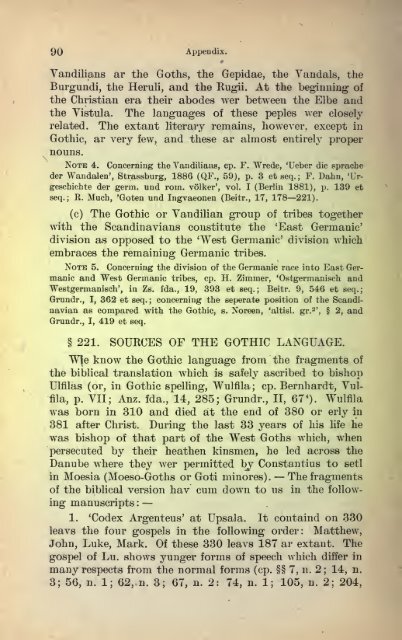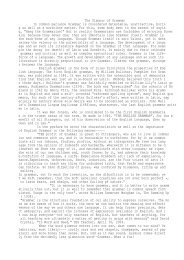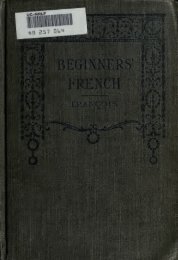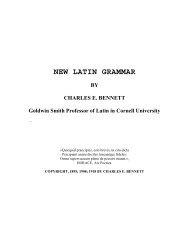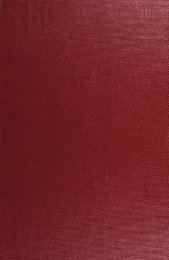A Gothic grammar with selections for reading and a ... - EducationNest
A Gothic grammar with selections for reading and a ... - EducationNest
A Gothic grammar with selections for reading and a ... - EducationNest
Create successful ePaper yourself
Turn your PDF publications into a flip-book with our unique Google optimized e-Paper software.
90 Appendix.<br />
V<strong>and</strong>ilians ar the Goths, the Gepidae, the V<strong>and</strong>als, the<br />
Burgundi, the Heruli, <strong>and</strong> the Kugii. At the beginning of<br />
the Christian era their abodes wer between the Elbe <strong>and</strong><br />
the Vistula. The languages of these peples wer closely<br />
related. The extant literary remains, however, except in<br />
<strong>Gothic</strong>, ar very few, <strong>and</strong> these ar almost entirely proper<br />
nouns.<br />
NOTE 4. Concerning the V<strong>and</strong>ilians, cp. F. Wrede, 'Ueber die sprache<br />
der W<strong>and</strong>alen', Strassburg, 1886 (QF., 59), p. 3 et seq. ; F. Dahn, 'Ur-<br />
geschichte der germ, und rom. volker', vol. I (Berlin 1881), p. 139 et<br />
seq.; K. Much, 'Goten und Ingvaeonen (Beitr., 17, 178221).<br />
(c) The <strong>Gothic</strong> or V<strong>and</strong>ilian group of tribes together<br />
<strong>with</strong> the Sc<strong>and</strong>inavians constitute the 'East Germanic'<br />
division as opposed to the 'West Germanic' division which<br />
embraces the remaining Germanic tribes.<br />
NOTE 5. Concerning the division of the Germanic race into East Germanic<br />
<strong>and</strong> West Germanic tribes, cp. H. Zimmer, 'Ostgermanisch <strong>and</strong><br />
Westgermanisch', in Zs. fda., 19, 393 et seq.; Beitr. 9, 546 et seq.;<br />
of the Sc<strong>and</strong>i-<br />
Grundr., I, 362 et seq. ; concerning the seperate position<br />
navian as compared <strong>with</strong> the <strong>Gothic</strong>, s. Noreen, 'altisl. gr. 2 ', 2, <strong>and</strong><br />
Grundr., I, 419 et seq.<br />
221. SOURCES OF THE GOTHIC LANGUAGE.<br />
WJe know the <strong>Gothic</strong> language from the fragments of<br />
the biblical translation which is safely ascribed to bishop<br />
Ulfilas (or, in <strong>Gothic</strong> spelling, Wulfila; cp. Bernhardt, Vul-<br />
Wulfila<br />
ffla, p. VII; Anz. fda., 14, 285; Grundr., II, 67 4<br />
).<br />
was born in 310 <strong>and</strong> died at the end of 380 or erly in<br />
381 after Christ. During the last 33 years of his life he<br />
was bishop of that part of the West Goths which, when<br />
persecuted by their heathen kinsmen, he led across the<br />
Danube where they wer permitted by Constantius to setl<br />
in Moesia (Moeso-Goths or Goti minores). The fragments<br />
of the biblical version hav cum down to us in the follow-<br />
ing manuscripts :<br />
1. 'Codex Argenteus' at Upsala. It containd on 330<br />
leavs the four gospels in the following order: Matthew,<br />
John, Luke, Mark. Of these 330 leavs 187 ar extant. The<br />
gospel of Lu. shows yunger <strong>for</strong>ms of speech which differ in<br />
many respects from the normal <strong>for</strong>ms (cp. 7, n. 2 ; 14, n.<br />
3; 56, n. 1; 62, n. 3; 67, n. 2: 74, n. 1; 105, n. 2; 204,


